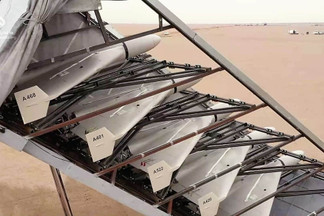Posted by BW Actual on Sep 19th 2022
BLACKWATER USA | DAILY BRIEF
Coming Up This Week
- The UN General Assembly - an annual meeting of world leaders - convenes in New York starting tomorrow. The U.S. reluctantly issued visas for the Russian delegation last week, following Russia's loud complaints about delays. Ukraine will feature heavily on the agenda, but nobody expects any real progress from the summit.
- The U.S. Federal Reserve meets Wednesday, and will almost certainly raise interest rates - either by three-quarters of a point to 3.00% or by a full point to 3.25%. Analysts predict further rate hikes at the Fed's November and December meetings.
Commodity Prices
- Aluminum: $2,277/ton
- Antimony (ingot min. 99.65% fob China): $12,650/ton
- Cobalt: $51,955/ton
- Copper: $7,762/ton
- Gold: $1,662/toz
- Lead: $1,889/ton
- Natural Gas (Nymex): $7.64/MMbtu
- WTI Crude Oil (Nymex): $84.13/barrel
- Zinc: $3,154/ton
- The UK thinks Russia is going to broaden its assault on civilian infrastructure in Ukraine as a tactic to undermine the morale boost Ukraine is getting from its successful counteroffensive.
- Ukraine has been sharpening its focus on Russian supply hubs in Kherson, which is the only place west of the Dnipro River where Russia still holds territory. Ukraine's progress there has been slower than in the northeast - perhaps because Russia anticipated and prepared for the assault in the south but was surprised by the one in the northeast.
- Ukrainian military officials are worried about the arrival of Iranian-made drones on the battlefield: Russia reportedly used one to destroy a U.S.-supplied M777 howitzer, and Ukraine is asking allies to give it tools to defend against the drones - or similar drones to counterattack. A NYT article pasted below has more detail.
- The head of the Russian Security Council, Nikolai Patrushev, landed in China yesterday for two days of security consultations. The Security Council says Russia and China agreed to deepen security cooperation and hold more joint exercises, so this is probably the first of many senior visits.
- Pres. Raisi gave an interview with 60 Minutes - his first ever with a western reporter - in which he called U.S. sanctions on Iran "tyrannical" and said Iran "cannot trust the Americans."
- The 60 Minutes crew said the conversation seemed cordial, but reported facing the typical Iranian hijinks: one cameraman's phone was confiscated and held for several hours, and another's shot was blocked as Lesley Stahl and Raisi were ending the interview.
- Iranians are protesting following the death of 22-year-old Mahsa Amini in the custody of the morality police, who had arrested her for violating hijab rules. Local reports say she was beaten in the course of her arrest.
- The NYT reported on Friday that Iran's Supreme Leader, Ayatollah Khamenei, is "gravely ill," and multiple anonymous sources say he underwent surgery for a bowel obstruction last week.
- Reports that Khamenei is on the verge of death seem overblown: new videos showed him addressing a crowd at a religious event on Saturday.
- Islamic State belatedly claimed its first two operations in the West African country of Benin more than two months after the attacks allegedly took place (Long War Journal says only one of the early July incidents had been previously corroborated by other reports). Al Qaeda affiliate JNIM is far more active in Benin, and has been responsible for the vast majority of the ~20 attacks there since 2019.
Russia and Iran never acknowledged striking a deal for the Shahed-136 attack drones, but a senior Ukrainian military official said remnants were discovered on the ground during the counteroffensive that Kyiv began in the northeast earlier this month.
The powerful weapon is a so-called kamikaze drone carrying a warhead of about 80 pounds. Its appearance in Ukraine is the first time it has been deployed outside the Middle East.
The use of the Shahed-136 drones shows that while Russia remains mostly isolated internationally and was even rebuked just last week by leaders of China and India, Moscow has still found support from Iran. It also adds a layer of geopolitical complexity to the conflict as more nations are drawn into providing weaponry.
In its first use in Ukraine, the Iranian drone blew up an American-supplied M777 howitzer used by the Ukrainian military, Colonel Rodion Kulagin, the commander of artillery operations in the Kharkiv counteroffensive, said in an interview.
“It blew the triple-seven in half,” Colonel Kulagin said. “Instead of firing 100 artillery shells, it’s easier to release one of these drones” to seek a target, he added.
Half a dozen strikes destroyed howitzers and armored vehicles, killing four soldiers and wounding 16, he said. Russia’s use of Iranian drones was reported earlier by The Wall Street Journal.
The appearance of the drones — even amid Ukraine’s otherwise successful and ongoing counteroffensive in the northeast — prompted Colonel Kulagin to appeal to Ukraine’s Western allies to quickly provide defenses or a similar weapon to strike back.
“Give us something like this,” Colonel Kulagin said.
Drones have played a crucial role in the conflict already. The United States has supplied Ukraine with its Switchblade drones, and an attack on Russia’s Black Sea Fleet headquarters involved a drone. Ukraine has also deployed Turkish-made Bayraktar TB2 drones firing guided missiles.
The Shahed-136 is a delta-wing drone launched from the back of a flatbed truck. Colonel Kulagin said he was not aware of any intelligence documenting the presence of the launcher or drones on the Russian side of the front. But remnants of a drone that crashed near the town of Kupyansk, apparently after malfunctioning, proved the weapon is in use, he said.
The weapon drops out of the sky without warning, according to Colonel Kulagin and a Ukrainian artillery officer who witnessed one of the strikes. It is accurate enough to hit a self-propelled howitzer in a spot near the turret where gunpowder is stored, setting off secondary explosions, Colonel Kulagin said.
In such strikes nothing remains of the drone after detonation, he said. But witness accounts and the nature of the explosions, which were distinct from the damage caused by artillery fire, made the Ukrainian military confident in its assessment that the drones had been successfully deployed.
Debris from the crashed drone indicated that the Russian military had removed its Iranian markings. The drone was mislabeled on a winglet as a Geran-2 Russian-made drone, Colonel Kulagin said.
“It’s a very serious problem,” he said. Without countermeasures, he added, “they will destroy all our artillery.”
It is unclear how many Iranian attack drones Russia has acquired. The U.S. national security adviser, Jake Sullivan, said in July that Russia intended to buy several hundred Iranian drones of various types.
There was no immediate response from Washington on the reports that the Shahed-136 drones were being used in Ukraine. On Friday, Gen. James Hecker, the top U.S. air commander in Europe, said that Russia was only “just getting” Iranian drones “so we really haven’t seen how they’re going to use them yet or how effective they’re going to be.”
The Shahed-136 drones have so far only been deployed in northeastern Ukraine, Colonel Kulagin said. The first successful attack, on the M777 howitzer, was near the town of Chuguyev in August, before the counteroffensive began. The other strikes occurred in the past week or so, he said.
“They are testing them and have concentrated them in this region,” Colonel Kulagin said.
Captain Volodymyr Danchenko, an artillery officer whom the Ukrainian military made available for a telephone interview, said he witnessed a strike on a self-propelled howitzer — a tracked, armored vehicle that parks briefly to fire artillery before moving to avoid counterattacks.
The drone streaked in and obliterated the howitzer, he said.
“It was not like artillery that hit us before,” he said. “I haven’t met something like this before.”

